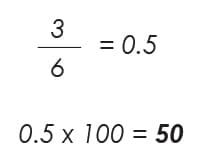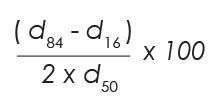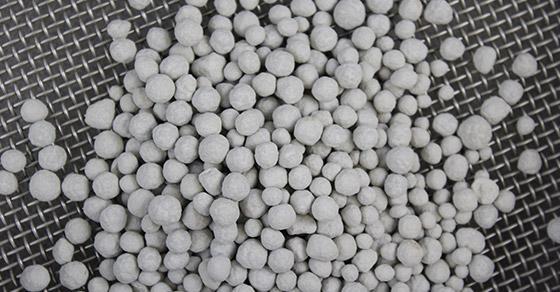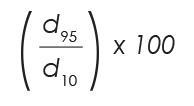Fertilizer and soil amendment products have had a long evolution in terms of quality. At the start of modern agriculture, growers had few options – most of them not ideal. But advanced manufacturing methods, coupled with a greater understanding of nutrient and particle performance, has allowed producers to zero-in on precise product specifications to create a granular fertilizer product that performs exactly as desired.
A product that is not produced to spec can cause a number of issues. This might include:
- Breaking down too quickly
- Breaking down too slowly
- Becoming segregated during shipping or handling
- Producing excessive dust, yielding lost product and a hazardous work environment
- Caking during storage or transport, and subsequent difficulty of spreading and handling
- Inconsistent product on the consumer end
- Inconsistent flow properties
- Increased potential for nutrient runoff
As modern technology allows, however, the above issues are largely circumvented by using production techniques to reach precise particle characteristics. While these characteristics (and the combination thereof) often vary depending on the product, some of the most commonly targeted physical specifications are listed here, along with the production techniques used to influence them.
Targeted Physical Particle Characteristics
Particle Size
Particle size is a critical factor in the performance of fertilizer and soil amendment products and in most cases, is the first characteristic producers are looking to target. The particle size of a product influences two key parameters in performance:
- Rate of nutrient/active ingredient delivery: In general, the larger the particle size, the longer the product will take to break down, with powders offering fastest nutrient delivery (though they also often become windblown). It’s important to note that particle size is not singularly responsible for the rate of breakdown; many other factors come into play as well. Particle size can also influence the rate at which a fertilizer dissolves.
- Segregation of particles: Segregation occurs when a mixture of particles of varying sizes naturally group together according to size, forming a heterogeneous mixture, instead of remaining homogeneous. This often results in uneven application and unpredictable results.
Particle Size Distribution (PSD)
Particle size distribution is a measurement of the amount of material that falls into each of the various size ranges within a given sample.
In addition to PSD, there are a number of other indicators used to define a sample’s size qualities in more detail….
SGN (Size Guide Number)
The size guide number of a material is a commonly used specification to describe particle size characteristics. SGN is the mean, or average, of the particle sizes that make up the product.
This number is calculated by multiplying the average particle size (in mm) by 100.
UI (Uniformity Index)
The uniformity index of a product is a measurement of the relative difference in size between particles.
A UI between 40 – 60 is ideal for fertilizer (the larger the number, the greater the uniformity), as this will help to ensure that particles are uniform (mitigating potential segregation issues), but different enough within that uniformity that they will spread efficiently and maximize storage or packing space.
The UI of a product is calculated through the following equation:
d95 – size of sieve opening that retains 95% of sample (smaller granule diameter), i.e., the amount of particles at or above this specific diameter
d10 – size of sieve opening that retains 10% of sample (larger granule diameter) i.e., the amount of particles at or above this specific diameter
Example:
If d95 = 3.0mm and d10 = 6.0mm, then the equation is as follows:

Since 50 falls within the ideal 40-60 UI range, this is an acceptable UI.
GSI (Granulometric Spread Index)
Granulometric spread index is another size parameter producers are looking to control. This number quantifies how much variance exists between particles in a given sample. The lower the number, the more uniform the sample.
GSI is calculated using the following equation:

d84 and d16 = the diameter of mass fraction at the 84% and 16% percentile level, respectively
d50 = median diameter of the sample
Surface Area to Volume
Also important in particle size is the surface-area-to-volume, or surface-to-volume ratio. This may be given as:
- SA:V
- SA/V
This ratio illustrates the relationship between the total volume of the granule compared to its total amount of surface area. SA:V is important when working with fertilizers and soil amendments, because it influences the rate of active ingredient delivery.
Particles with a high surface-area-to-volume ratio allow increased contact with the soil, which promotes faster product delivery.
Conversely, particles with a low surface-area-to-volume ratio will inherently take longer to break down and deliver the active ingredient. While in most cases producers are looking to promote faster delivery, the SA:V of a product can be used to control or delay delivery of the active ingredient when desired, such as when producing controlled-release or slow-release fertilizers.
As can be seen in the illustration above, smaller particles have comparatively more surface area to volume than a larger particle.
Note how as the granule breaks down, there is an increasing amount of surface area exposed and the surface area to volume ratio increases.
Factors that Influence Particle Size
Particle size is generally influenced by the method of production and the process parameters used in the production setting – most notably retention time in the granulation unit.
In granulation (or “tumble growth agglomeration”) processes, various equipment configurations can be employed to obtain a product within a desired size range. If a pin mixer or pugmill mixer was used as the sole granulation device, the resulting granules would generally be smaller than those produced using the combination of a mixer and an additional device, such as an agglomerator or disc pelletizer.
In general, the longer the retention time, the larger the granules (up to the maximum size that the material characteristics would allow for).
Moisture content also plays a role in the size of the granules, as up to a certain point, the more moisture that is added to a seed pellet or particle, the more tacky it will become and the more fines it is likely to pick up during processing.
Crush Strength
Crush strength, or hardness, is another key specification in soil product performance. As the name suggests, this metric indicates how much pressure is required to break a granule. Crush strength is often used as a predictor for the amount of degradation due to handling that will occur with a product.
For example, a low crush strength can cause granules to break down too easily (for this reason, granules with a low crush strength may break down at the bottom of a super sac under the weight of the product).
Achieving the optimum crush strength for the product will help to ensure that it is capable of withstanding handling, bagging, storage, etc., but will still break down as needed under standard field conditions.
Crush strength is measured in the amount of pressure (lb. or kg.) it takes to crush a single granule. Crush strength for fertilizer and soil amendment products generally falls around 4-6 pound-force (LBF).
Factors that Influence Crush Strength
The crush strength of a product can be influenced by several factors – most notably, the binding agent.
During the granulation process, the liquid binding agent causes the particles to become tacky, allowing them to pick up additional fines as they tumble. The binder affects crush strength in two important ways:
Green Strength: The crush strength of the pellets in their wet state is referred to as “green strength.” Reaching a suitable green strength is critical to maintaining pellet integrity throughout the process, as pellets must be able to withstand the various drop and transfer points that occur during processing. If an appropriate green strength is not achieved, pellets will break up during processing.
End Product Crush Strength: Upon drying, the binder enhances the bond between the particles to influence the end product’s crush strength. The amount of binder, as well as the type of binder, will impact this value. Binders are available by the hundreds, with some being better than others in the context of fertilizer.
Achieving a uniform distribution of the binder is also important. If binder and raw material feedstock are not properly combined into a homogeneous mixture, the finished product can vary in crush strength as a result of the uneven distribution.
Other factors that can be used to control crush strength include chemical makeup, agglomeration equipment/process to manufacture the granule, material preconditioning, and moisture content. The different components within a product can also sometimes react, producing a stronger bond.
Particle shape can also impact granule strength. Since the sphere is the strongest shape, spherical particles will generally hold their shape and be less prone to premature breakdown than jagged or irregular granules, which are more easily influenced by external pressures.
Bulk Density
Bulk density is also a critical characteristic when working with fertilizers and soil amendments. Bulk density is the relationship between weight and volume of a given bulk solid material.
The bulk density of a material has a substantial impact on end product performance and handling, with implications in packing, shipping, metering, and spreading.
Bulk density is measured as the weight of a material at a given volume. For this reason, if the bulk density of a material is known, along with one other variable, the missing variable (weight or volume) can be calculated.
There are several variations on the bulk density measurement. The two most common bulk density measurements are loose bulk density and packed bulk density:
Loose Bulk Density
The “bulk density” of a material generally refers to the material’s loose bulk density. This measurement is simply the material’s resting density after having been poured into a container, where void spaces exist between particles.
Packed Bulk Density
Conversely, packed bulk density, or “tapped density” is a measurement of the material’s bulk density after the container of material has been tapped until no further change occurs. Tapping causes the void spaces to become filled in by smaller particles (if applicable).
The difference between loose and packed bulk density is important to measure, because it can have several ramifications….
A material with a greater packed bulk density means that more material can fit in a smaller space. In some cases, this may be an advantage, such as when looking to maximize the allotted volume of a container. In other cases, it can be a disadvantage: material with a much greater packed bulk density may be packaged at loose density, but after transportation, appears significantly lower in volume. This can be especially troubling with consumer products: if a bag of product leaves the production facility full, but once on the shelf appears only half full, consumers may perceive the product as a lesser value.
Factors that Influence Bulk Density
A myriad of factors can influence the bulk density of a material, making it a complex specification to control in production. The most influential parameters are:
Moisture Content
In general, as the moisture content of a material increases, so too does the bulk density. This is because moisture adds weight. However, this is not the case with all materials; some materials, such as bentonite clay, will swell with added moisture, meaning that both weight and size of the particle are increasing.
Density of Each Individual Particle
Two particles of the same material and same size can have differing bulk densities. This is because a greater volume of material can be packed into the same size particle.
Production methods can greatly influence the density of particles. A pin mixer, for example, employs an intense spinning motion to create a homogeneous mixture of solid and liquid feed. This intense spinning action causes the particles to be more dense than if they were created in a disc pelletizer or granulation drum alone.
Particle Shape
Particle shape is another significant factor in the bulk density of a material, as it has a direct effect on the volume of void spaces between particles.
Particle Shape
In addition to its influence on bulk density, particle shape is an important target characteristic in its own right as well. Fertilizers and soil amendments can be produced in a variety of shapes – from perfectly spherical to jagged-edged angular granules and every variation in between.
Particle shape has a number of influences on the performance of a soil product:
- Packing ability
- Flowability
- Attrition/Amount of dust produced
Attrition
Attrition is the breakdown of particles into dust as a result of granule-to-granule or granule-to-equipment contact. Minimizing attrition is desirable in most cases to reduce product lost as dust, to avoid a hazardous work environment, and to mitigate other dust-related issues.
Factors that Influence Attrition
Particle shape has a direct effect on the amount of attrition that occurs; angular granules are more likely to result in attrition than round granules, as a result of the jagged edges being knocked off. For this reason, round granules are typically considered to be a more premium product.
Hygroscopicity
Hygroscopic materials are capable of exchanging moisture with the surrounding atmosphere. This can result in off-spec product that does not handle or perform as intended. Similarly, it can also foster the creation of crystal bridges between particles, causing caking to occur.
Hygroscopicity is generally controlled through the chemical composition of a product, as well as through surface treatments or coatings to inhibit moisture absorption.
Solubility
Similar to hygroscopicity, targeting a specific solubility, or rate of dissolving, contributes to the overall rate of break down as well. One way this can be controlled is through surface treatments and coatings.
Process & Product Development
Despite the fertilizer industry being relatively well developed, defining the process parameters that will work together to produce precise product specifications is often a process that requires thorough R&D. Variation in raw materials, changes in production settings, and more, hold the potential to significantly “throw off” a process, or make it challenging to define on a consistent, commercial-scale basis.
Combined with the rising interest in producing specialty fertilizers and soil amendment products, a surge in process and product development around fertilizers is being seen. Testing in a facility such as the FEECO Innovation Center has become increasingly critical to the success of granulation processes. Some companies are even investing in their own granulation pilot plants to serve their ever-expanding product development needs.
Process engineers in the Innovation Center work with producers to test various equipment configurations, binders, and a myriad of other process parameters to develop a process that can consistently produce the intended end product on a commercial scale.
Conclusion
As the fertilizer industry’s most experienced granulation expert, FEECO has been the leading provider in custom equipment and process development for specialty fertilizer and soil amendment products since 1951. We can help you take your idea from concept to full-scale production facility – and manufacture the equipment. For more information, contact us today!




